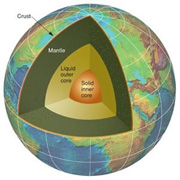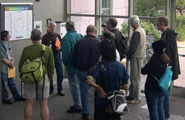


Silica is one of the most common minerals on Earth. Not only does it make up two-thirds of our planet's crust, it is also used to create a variety of materials from glass to fiber optic cables. Yet new results generated by a team of physicists from Ohio State University show that this mineral only populates our planet superficially — in other words, silica is relatively uncommon deep within the Earth. Using several of the largest supercomputers in the nation, including the National Energy Research Scientific Computing Center’s (NERSC) Cray XT4 "Franklin" system, the team gleaned details that one day may help scientists predict complex geological processes like earthquakes and volcanic eruptions. More>
 After a long hiatus, the Lab is once again providing tours for members of the public, with the first one conducted last week. Scientists and engineers guide the visitors through research areas, demonstrating technology and discussing potential applications. Stops also include the Advanced Light Source, the National Center for Electron Microscopy, the 88-Inch Cyclotron, and other facilities. E-mail [email protected] for more information. Ken Wolf of the Engineering Division is pictured leading last week’s tour.
After a long hiatus, the Lab is once again providing tours for members of the public, with the first one conducted last week. Scientists and engineers guide the visitors through research areas, demonstrating technology and discussing potential applications. Stops also include the Advanced Light Source, the National Center for Electron Microscopy, the 88-Inch Cyclotron, and other facilities. E-mail [email protected] for more information. Ken Wolf of the Engineering Division is pictured leading last week’s tour.
 As part of his initiative to improve community relations, Director Paul Alivisatos last month sent a letter to all residents of the Lab’s neighboring communities. The letter offered a brief description of the Lab and its mission of “focusing on solutions.” He also explained several areas of research, including smart buildings and better batteries, biofuel production, human health, and the Carbon Cycle 2.0 Initiative. The letter also included a list of 25 Lab breakthroughs that have improved the world. About 25 percent of Lab employees live in Berkeley, 12 percent in Oakland, and 4 percent in Albany. Go here to read the letter.
As part of his initiative to improve community relations, Director Paul Alivisatos last month sent a letter to all residents of the Lab’s neighboring communities. The letter offered a brief description of the Lab and its mission of “focusing on solutions.” He also explained several areas of research, including smart buildings and better batteries, biofuel production, human health, and the Carbon Cycle 2.0 Initiative. The letter also included a list of 25 Lab breakthroughs that have improved the world. About 25 percent of Lab employees live in Berkeley, 12 percent in Oakland, and 4 percent in Albany. Go here to read the letter.
 From such lofty publications as the New York Times and R&D Magazine to local outlets like the San Francisco Chronicle and the Daily Cal, Berkeley Lab is a newsmaker, appearing in hundreds of news sites all over the world. To help employees better track where and how the Lab and its researchers are mentioned, the Public Affairs Office has created a daily updated, searchable media blog, which includes brief summaries of articles that link to full stories. The blog is accessible from the Lab’s homepage and on the News Center. Those interested can have a link to the blog e-mailed to them every Friday. Have you seen Berkeley Lab mentioned in a news outlet? If so, e-mail the link and we’ll add it to the blog.
From such lofty publications as the New York Times and R&D Magazine to local outlets like the San Francisco Chronicle and the Daily Cal, Berkeley Lab is a newsmaker, appearing in hundreds of news sites all over the world. To help employees better track where and how the Lab and its researchers are mentioned, the Public Affairs Office has created a daily updated, searchable media blog, which includes brief summaries of articles that link to full stories. The blog is accessible from the Lab’s homepage and on the News Center. Those interested can have a link to the blog e-mailed to them every Friday. Have you seen Berkeley Lab mentioned in a news outlet? If so, e-mail the link and we’ll add it to the blog.
 In The News: ATLAS Pops Up at New York Academy of Sciences
In The News: ATLAS Pops Up at New York Academy of Sciences Understanding the intricacies of subatomic physics isn’t easy, but in Voyage to the Heart of Matter: The Atlas Experiment at CERN, the concepts literally leap off the page. Even a reader familiar with the Large Hadron Collider’s design and goals will gain fresh appreciation from this pop-up story featuring ATLAS, says the reviewer for the June 5 issue of Science News. The book’s English version premiers this week at the New York Academy of Sciences, in an event organized by Michael Barnett of the Physics Division, head of public outreach for ATLAS. More>
Today
at Berkeley Lab encourages feedback and story ideas
Deadline for submissions is 10 a.m. two days prior to publication
TABL is produced by Public Affairs' Communications Group